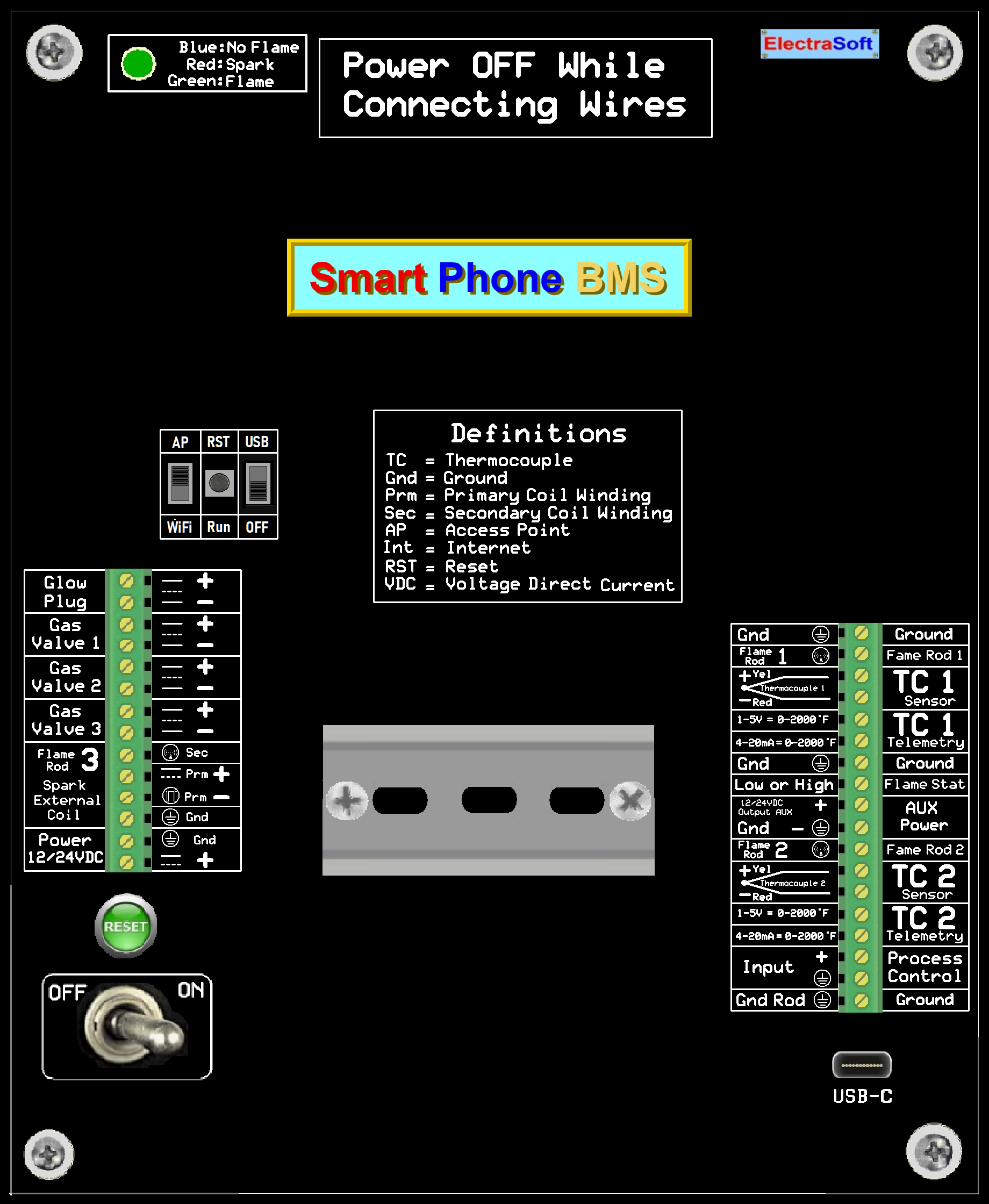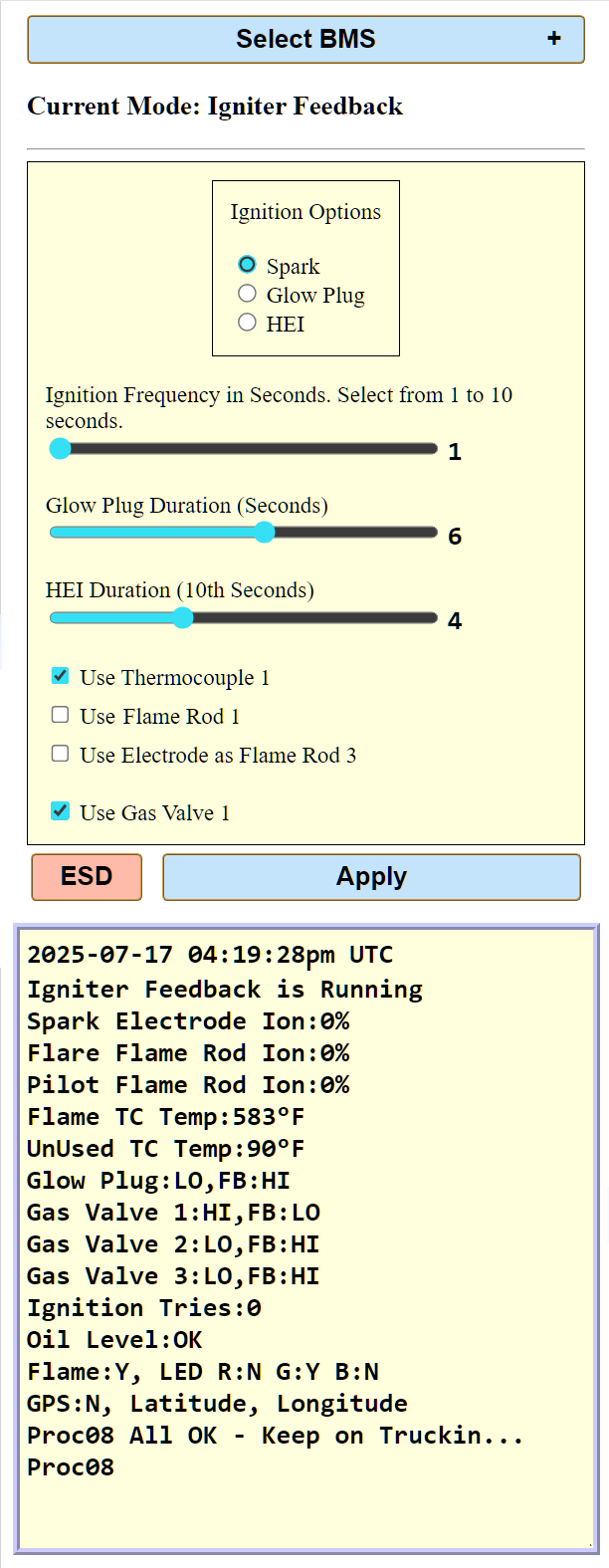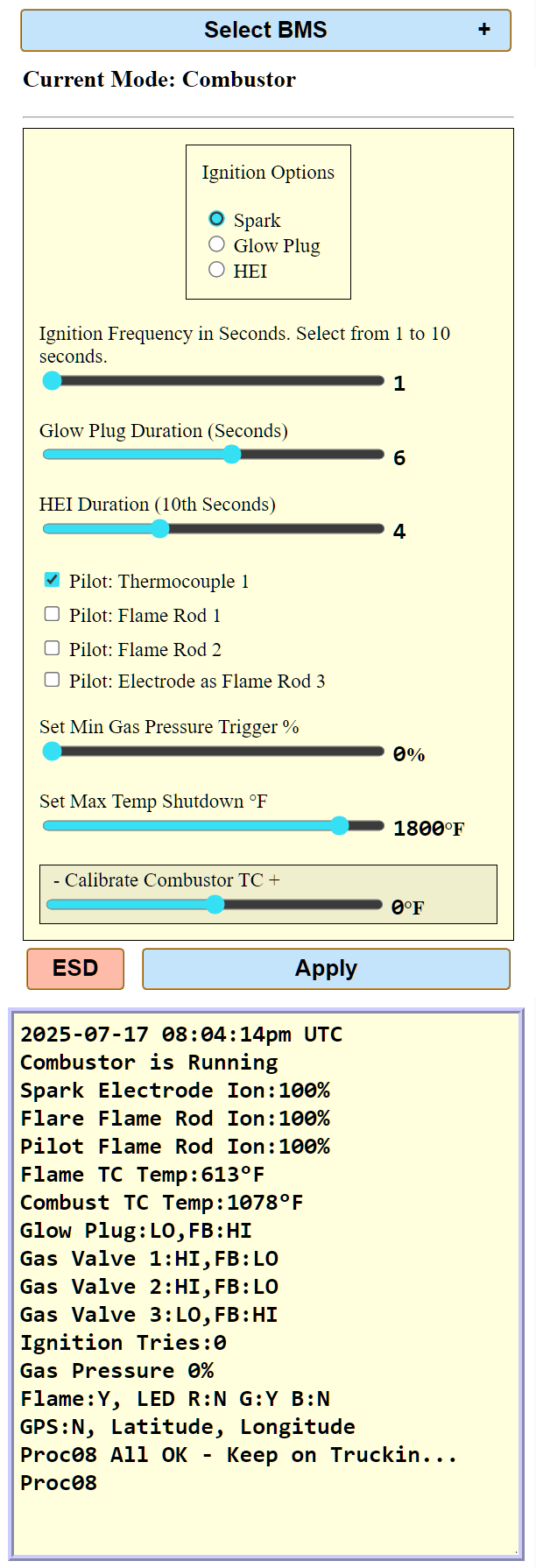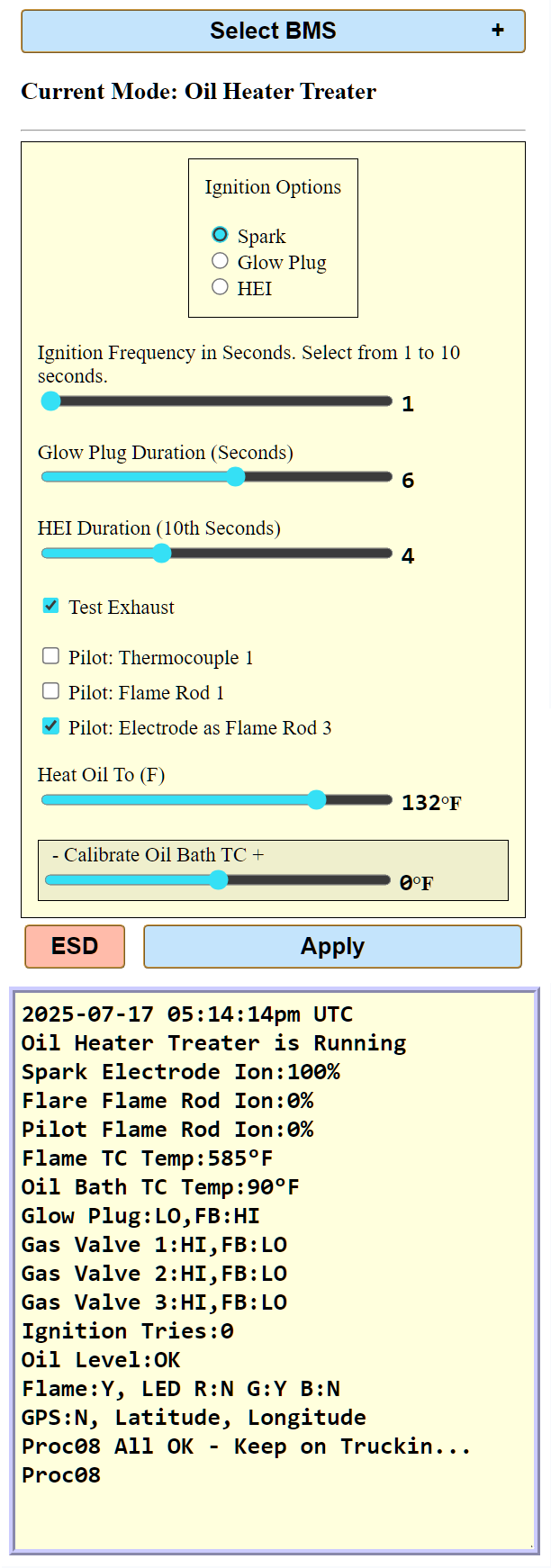SmartPhone BMS Q&A
What are the Electrical and Grounding Best Practices?
- Use isolated earth ground to reduce false ionization feedback.
- Shield ignition coil wires from sensor runs to avoid cross-talk.
- Ground flame rod shield separately from chassis when using high-energy ignition.
Burner Management System Q&A
Q: What WiFi devices do I need to control the SmartPhone BMS?
A: The following is a list of some Devices Compatible with SmartPhone BMS...
| Device |
Compatibility Notes |
| Android OS |
Fully compatible with SmartPhone BMS apps via Bluetooth, Wi-Fi, and serial. Supports real-time monitoring, fault alerts, and parameter control. |
| Samsung Galaxy S25 Ultra |
Fully compatible with SmartPhone BMS. Supports advanced AI and charging protocols. |
| Samsung Galaxy S24 Ultra |
Compatible with SmartPhone BMS. Shares similar architecture and charging ecosystem. |
| Google Pixel 9 Pro XL |
Compatible via GrapheneOS kernel modules for BMS integration. Ideal for custom setups. |
| OnePlus 13T |
Excellent compatibility with UFCS and PPS fast-charging protocols. Works well with BMS. |
| Motorola Edge 50 Ultra |
Listed in Motorola’s Smart Connect compatibility chart. Supports PC and display sync. |
| Asus ROG Phone 8 Pro |
Supports DisplayPort and advanced cooling; compatible with BMS-like systems. |
| Xiaomi Mi 14 Pro |
Supports PD3.0, QC4, and advanced charging protocols. Compatible with SmartPhone BMS. |
| Sony Xperia 1 VI |
Compatible with U.S. carriers and supports advanced LTE/5G bands. BMS support likely. |
| Honor Magic6 Pro |
Supports wide carrier bands and advanced charging; compatible with SmartPhone BMS. |
| Vivo X100 Pro |
Supports PD, QC, and advanced battery protocols. Compatible with SmartPhone BMS. |
| Tablets |
Supports SmartPhone BMS. |
| Computers |
Supports SmartPhone BMS. |
| Smartphones |
All Smartphones should support SmartPhone BMS. |
Q: Can you fix a Profire PF3100 that stopped sparking?
A: Yes. We service and repair all Profire models, including the PF3100. Spark failure can result
from a damaged ignition coil, miswired pilot valve, or grounded flame rod. We test voltage output, verify
coil enable signals, and inspect module communication. Our team can replace faulty components and
reconfigure ignition settings using Profire’s diagnostics interface.Q: What are some of the reasons that the thermocouple stopped working on my Profire PF2200?
A: Thermocouple issues on the PF2200 often stem from corrosion, loose wiring, reversed polarity,
or grounding faults. We check for continuity, inspect terminal connections, and verify temperature
readings against expected values. If the system reads ambient temperature or throws a lockout, we’ll
test the sensor directly and replace it with a certified Type-K or PT-100 RTD as needed.Q: Do you service FlareTech?
A: Yes. We service FlareTech flare systems, pilots, and ignition modules—including retractable
igniters and PMI panels. Whether it’s a failed spark tip, thermocouple fault, or pilot monitoring
issue, our crew can troubleshoot and repair it. We also retrofit SmartPhone BMS onto FlareTech units
for remote diagnostics and ignition control.Q: Do you service Profire Energy Systems PF3100, PF2200, PF2100?
A: Yes. We service all Profire Energy Systems models, including the PF3100, PF2200, and PF2100.
Whether it's ignition faults, thermocouple issues, or controller diagnostics, our team is equipped to
troubleshoot, repair, and retrofit these systems to meet EPA compliance and operational safety
standards.Q: How do I diagnose a failed flame rod on my Platinum Control Systems-600 BMS?
A: Start by checking for a proper ground path and clean flame rod surface—carbon buildup or
corrosion can interrupt flame rectification. Use a microamp meter in series with the flame rod circuit
to measure flame signal strength; values below 1 µA DC typically indicate failure. Also verify flame
quality and burner grounding. If the rod is scratched or pitted, replace it to restore reliable flame
detection.Q: How does a flame igniter Shot Tube work?
A: A flame igniter shot tube works by launching a flame front through a pipe to ignite a flare or
pilot burner. The tube fills with a fuel/air mixture—either manually or via a self-inspirating design—and
a spark ignites the mixture at the base. The resulting flame travels rapidly through the tube (typically
1–2 inches in diameter) and ignites the flare tip or pilot nozzle at the end. This produces a visible or
audible confirmation of ignition. Shot tubes are ideal for remote sites and can operate without
compressed air, making them reliable for manual or automatic flare systems.Q: Can SmartPhone BMS control shot tubes in remote New Mexico sites?
A: Yes. SmartPhone BMS integrates seamlessly with shot tube ignition systems, even in remote NM
and TX locations. It enables timed fuel/air purging, ignition sequencing, and real-time diagnostics—without
needing compressed air. The system confirms ignition via flame signal feedback and can be configured
for manual or automatic retries, making it ideal for rugged field conditions.Q: How do firetube burners work?
A: Firetube burners operate by directing a flame into a cylindrical firetube surrounded by water
or process fluid. The burner mixes fuel and air, ignites the mixture, and the hot combustion gases travel
through the tube, transferring heat to the surrounding fluid via conduction. This setup is common in
heater treaters, separators, and line heaters. The SmartPhone BMS can monitor flame signal, temperature
rise, and burner cycling to optimize performance and safety.Q: Can you repair ACL 3200, 4000?
A: Yes. We repair ACL 3200 and 4000 flare stack ignition systems, including pilotless and
retractable igniters. Common issues include solenoid failure, weak spark, voltage drop, and grounding
faults. We test ignition output, verify DIP switch settings, and inspect flame rod integrity. Our team
can retrofit SmartPhone BMS for enhanced diagnostics and remote control.Q: Do you service Combustex?
A: Yes. We service Combustex burner management systems, pilot assemblies, and safety shutoff
valves. Whether it’s a BMS-2000 shutdown condition, pilot valve calibration, or controller fault, we
troubleshoot and repair all components. We also offer SmartPhone BMS retrofits for Combustex units to
enable remote monitoring, flame signal tracking, and EPA-compliant control logic.
Waste Gas Flare Stake Igniter BMS Q&A
Q: What does the BMS control in a flare stack igniter system?
A: The BMS manages: ignition timing, flame verification, spark delivery, and
safety shutdowns. It supports ionization feedback, thermocouple monitoring,
and direct ignition logic, ensuring reliable flare ignition across varied gas
compositions.Q: Do any of your BMS operate without external power?
A: Yes. We have systems that support solar-powered ignition modules
with built-in lithium batteries, enabling off-grid operation in remote oilfield
environments.Q: What flame detection methods are supported?
A: The SmartPhone BMS supports:
- Ionization via spark electrode plus up to two more flame rods
- Thermocouple feedback
These methods can trigger alarms, shut off gas valves, or disable sparking when flame
is confirmed.
Q: Is the system compatible with portable flare stacks?
A: Absolutely. The BMS is designed for mobile deployment, with rugged
enclosures and flexible ignition options that withstand relocation and harsh conditions.Q: What gases can be ignited?
A: The system handles a wide range of flammable gases including natural gas,
propane, butane, acetylene, hydrogen mixes, and more.Q: Can the BMS be configured remotely?
A: Yes. It features a Wi-Fi Access Point Server, allowing configuration and
monitoring via smartphone, tablet, or laptop. It has a biult-in Access-Point (AP) server, so
it needs no internet.Q: What happens if the flame fails during operation?
A: The BMS detects flame loss via ionization or thermocouple feedback and can:
- Disable sparking
- Shut off gas valves
- Trigger alarms
This ensures safety and prevents unburned gas release.
Q: Is this flare stack igniter for sale?
A: Yes. Pricing depends on the number of Burner Management System (BMS)
units ordered.Q: Is this site an oilfield flare ignition system supplier?
A: Absolutely. We deliver fully integrated flare ignition solutions
purpose-built for rugged oilfield environments—including ignition panels,
BMS controllers, and precision thermocouple sensing. These systems are easily
controlled via computer, tablet, or smartphone.Q: Can I run this BMS as a pilotless flare igniter system?
A: Yes. The system is engineered for pilotless operation, ensuring
reliable ignition without a standing flame.Q: Does this BMS have a high-energy ignition system for flare stack option?
A: Yes. The BMS supports high-energy ignition modules tailored for flare
stack applications, delivering reliable ignition even in wet gas conditions or
windy environments. Simply select the HEI Ignition option during configuration.Q: Will this BMS work with a flare tip ignition device in an oilfield
setting?
A: Yes. The BMS is designed to operate seamlessly with flare tip ignition
devices in an oilfield environments, supporting high-energy ignition, flame
verification, and remote configuration for reliable operation in demanding
conditions.Q: I need an automatic flare igniter with thermocouple?
A: Yes. Our flare igniter systems support automatic ignition with integrated
thermocouple feedback—providing reliable flame detection, re-ignition logic, and safety
shutdowns.Q: Will SmartPhone BMS work as a flare ignition control panel?
A: Yes. The SmartPhone BMS functions as a full-featured flare ignition control
panel, offering ignition sequencing, flame verification, and remote configuration via
computer, tablet, or smartphone.Q: Do you sell a solar-powered flare igniter?
A: Yes. We offer solar-powered flare igniters with continuous ignition and
battery backup. Visit our Solar Ignition Systems details page to explore
available models.Q: Will SmartPhone BMS support my flare stack ignition system with flame
arrestor?
A: Yes. SmartPhone BMS is compatible with flare stacks equipped with flame
arrestors, offering ignition control, flame sensing, and safety shutdowns for hazardous
environments.Q: Is SmartPhone BMS a gas flare ignition system for remote sites?
A: Yes. It’s designed for remote operation with solar power, built-in Wi-Fi, and
smartphone control—ideal for off-grid flare stacks.Q: Does SmartPhone BMS have built-in oilfield combustion safety equipment?
A: Yes. It includes flame detection via thermocouple or ionization, automatic
shutdown, and alarm outputs to meet oilfield safety standards.Q: Is SmartPhone BMS a flare stack igniter compatible with BMS?
A: Yes. It integrates ignition control, flame monitoring, and combustion
logic—fully compatible with flare stack igniters and BMS protocols.Q: Is SmartPhone BMS a low voltage flare ignition module?
A: Yes. It operates on 12V or 24V DC, making it ideal for solar-powered and
remote installations where low voltage is critical for safety and efficiency.Q: Is SmartPhone BMS a flare stack igniter with Modbus support?
A: Yes. It supports Modbus integration via 1–5V, 4–20mA, and TRUE/FALSE outputs.
You can mount it on a DIN rail and connect it to your Modbus RTU or PLC system for
real-time monitoring and control.
Combustor Incinerator Igniter BMS Q&A
Q: What does the BMS manage in a combustor or incinerator system?
A: The BMS oversees ignition control, flame verification, purge sequencing,
and safety interlocks, ensuring safe startup, continuous operation, and emergency
shutdown of combustion systems.Q: What ignition methods are supported?
A: SmartPhone BMS supports:
- High-Voltage Spark Ignition
- HEI High Energy Ignition
- Glow Plug Ignition
- Pilot-Assisted Ignition
These methods can be configured based on fuel type, burner geometry, and site
conditions.
Q: Can the BMS handle VOC destruction in incinerators?
A: Yes. The system supports temperature monitoring, combustion chamber
feedback, and flame stability logic, making it suitable for VOC destruction
in thermal or catalytic incinerators. VOC (Volatile Organic Compound) destruction in
incinerators refers to the process of using high temperatures to oxidize and break
down harmful VOCs into less harmful substances like carbon dioxide and water. This
process is crucial for controlling air pollution from industrial processes and ensuring
cleaner air emissions.Q: What safety features are built in?
A: The SmartPhone BMS includes:
- Master Fuel Trip (MFT) logic
- Purge control
- Ignition attempt tracking
- Redundant flame loss detection
These features comply with NFPA 85 and other industrial safety codes. A Master Fuel
Trip (MFT) logic system is a critical safety mechanism in power plants that
automatically shuts off all fuel sources to a boiler in response to abnormal or
dangerous operating conditions. This prevents explosions, furnace implosions, and
other hazardous events. The MFT system is designed to be fast, reliable, and
independent of the main control system, often employing hardwired circuits and
redundant safety mechanisms.
Q: Is the system compatible with remote or mobile incinerators?
A: Absolutely. The BMS supports solar-powered ignition modules,
Wi-Fi configuration, and low-voltage operation, ideal for remote or
portable deployments.Q: What happens if ignition fails or flame is lost?
A: The SmartPhone BMS initiates a shutdown sequence, disables fuel flow,
and logs the event in the monitor. It may also trigger alarms or require manual reset
depending on configuration.Q: Can the SmartPhone BMS integrate with emissions monitoring or SIS systems?
A: Yes. It supports Modbus, digital I/O, and analog
feedback, allowing integration with Safety Instrumented Systems (SIS) and
emissions control platforms. Emissions monitoring and safety instrumented systems (SIS)
are distinct but equally crucial aspects of industrial operations. While emissions
monitoring focuses on tracking and managing environmental impact, SIS are designed to
protect people and assets by preventing hazardous events.Q: Do you have a combustor for oilfield operations?
A: Yes. We offer combustors designed for oilfield vapor management, including models
with high destruction efficiency, wide turndown ratios, and rugged construction for
tank battery and remote site applications. Options include enclosed and open flare styles, with
support for pilotless ignition, thermocouple feedback, and SmartPhone BMS integration for
advanced burner control and remote monitoring.Q: Do you have an oilfield combustor for sale?
A: Yes. We offer oilfield combustors engineered for vapor control and emissions compliance,
including enclosed and open flare models. Each unit supports pilotless ignition, thermocouple
feedback, and SmartPhone BMS integration for remote monitoring and burner management. Our systems
are built for rugged field conditions and meet Quad O standards with destruction efficiencies
exceeding 98%.Q: What is a waste gas combustor system?
A:A waste gas combustor system is an engineered solution used to safely burn off excess or
unwanted hydrocarbon vapors from oilfield operations. These systems convert volatile organic
compounds (VOCs) and other emissions into less harmful byproducts through high-efficiency
combustion. Typically enclosed or open flare designs, they feature pilotless ignition,
thermocouple feedback, and integration with burner management systems like our SmartPhone BMS for
remote monitoring and control. Combustors help meet environmental regulations such as Quad O and
are built to withstand rugged field conditions.Q:Do you have a combustor flare stack package?
A:Yes. We offer complete combustor flare stack packages tailored for oilfield vapor control
and emissions compliance. Our systems include enclosed or open flare designs, pilotless ignition,
thermocouple feedback, and SmartPhone BMS integration for remote burner management. Each package is
engineered for rugged field conditions and meets Quad O standards with destruction efficiencies
exceeding 98%.Q: Do you have a high BTU combustor unit?
A:Yes. We offer high BTU combustor units engineered for oilfield vapor control, including
models rated up to 11.7 MMBtu/hr. These units feature wide turndown ratios, pilotless ignition
options, and SmartPhone BMS integration for remote monitoring and burner management. Ideal for
handling heavy hydrocarbon streams and meeting Quad O compliance standards.Q:Will you install a combustor with pilot ignition system?
A:Let us know where the installation is needed, and we’ll coordinate accordingly. Our team
is experienced in deploying pilot ignition systems for combustors in a variety of field conditions,
including Class I Div 2 hazardous locations. We offer both manual and electronic pilot assemblies
with flame sensing, and can integrate with your existing BMS or provide a complete turnkey solution.Q: What are the rules for EPA compliant combustor for oilfield?
A: To meet EPA compliance under NSPS OOOOb and EG OOOOc, oilfield combustors must achieve
a 95% reduction in methane and VOC emissions. This requires using enclosed combustion devices
(ECDs) with continuous pilot flame monitoring, visible emissions testing (Method 22), and net
heating value (NHV) verification. Units must be either manufacturer-tested and listed by the EPA
or field-tested within 180 days of startup. Continuous monitoring, data logging, and periodic
performance testing every 60 months are also required.Q: Where can I find a combustor with flame arrestor?
A: When we install SmartPhone BMS, we tailor the setup to your specific needs, including
support for combustors equipped with flame arrestors. These arrestors are essential for preventing
flashback and ensuring safe operation in Class I Div 2 environments. Look for units with integrated
air intake flame arrestors that are compliant with EPA and OSHA standards, and tested for thermal
resistance and detonation protection.Q: Can I install a SmartPhone BMS on a portable combustor for remote sites?
A: Yes. The SmartPhone BMS is designed for remote ignition control and monitoring of
portable combustors. It supports Wi-Fi access, GPS location tracking, flame sensing via
thermocouples or flame rods, and ignition drivers for spark, glow plug, or HEI plasma. Ideal
for remote sites, it allows technicians to configure and troubleshoot from a service truck or
control room, enhancing safety and efficiency.Q: Where can I buy a combustor with BMS integration?
A: Combustors with integrated Burner Management Systems (BMS) are available from vendors
offering EPA-certified enclosed combustion devices. SmartPhone BMS units feature direct spark i
gnition, flame sensing, Modbus/SCADA compatibility, and solar-powered options for off-grid deployment.
Look for models with dual burner control, real-time monitoring, firmware upgrade paths, and support
for remote diagnostics. For rugged environments, select units housed in UL-certified NEMA 4X
enclosures, offering superior protection against water, dust, and corrosion—ideal for Class I Div 2
installations and outdoor oilfield applications.Q: Can you do a combustor flare tip replacement?
A: Yes, we offer flare tip replacement services tailored to your combustor configuration.
Whether you're working with elevated stacks, enclosed ground flares, or mobile systems, we coordinate
safe and efficient replacements—often without the need for heavy-lift cranes. Our partners specialize
in engineered lifting solutions and rapid turnaround to minimize downtime while ensuring compliance
with environmental and safety standards.Q: Do you have a combustor with thermocouple feedback?
A: Absolutely. Our SmartPhone BMS supports combustors equipped with integrated thermocouple
feedback for real-time flame monitoring, diagnostics, and automated control. These systems enhance
operational safety by detecting flashback, verifying ignition, and triggering shutdown protocols
when necessary. Thermocouple feedback is especially critical in Class I Div 2 environments and can
be configured to meet EPA and OSHA compliance standards. With smartphone-based access, technicians
can monitor flame status, adjust parameters, and receive alerts—all from the comfort of a service
truck or remote location.Q: Can you retrofit pilot monitoring and ignition diagnostics?
A: Yes, our SmartPhone BMS is designed to support pilot monitoring and ignition diagnostics—even
in retrofit scenarios. The system initiates ignition by powering the transformer, opening pilot valves,
and verifying flame presence via flame rod or thermocouple sensors. Once ignition is confirmed, the BMS
transitions to main burner control and continues to monitor flame stability, fuel pressure, and
combustion air flow. With smartphone-based access, technicians can adjust ignition parameters, view
diagnostic alerts, and verify pilot status remotely—enhancing safety and reducing downtime in Class I
Div 2 environments.Q: What are Combustor for VOC destruction used for?
A: Designed for high-efficiency oxidation of volatile organic compounds (VOCs), this combustor
utilizes staged combustion and temperature modulation to ensure thorough breakdown of complex
hydrocarbon chains. Ideal for EPA-compliant waste gas flaring and industrial emission control.Q: What is a Combustor for tank vapor recovery?
A: Engineered to support vapor recovery operations, this unit offers low-NOx combustion and
adjustable air-fuel ratios, making it perfect for intermittent flows from storage tanks. Compatible
with recovery skids and BMS integrations.Q: Do you have a Combustor with solar ignition option?
A: When paired with our SmartPhone BMS, this combustor supports solar-powered ignition for
fully autonomous startups—even in remote, off-grid environments. The integrated solar-assisted spark
module offers dependable ignition without grid dependency, ideal for mobile VOC treatment units and
remote flare applications. System diagnostics and ignition events are monitored and logged via the
SmartPhone BMS for enhanced visibility and troubleshooting.
Oil Heater Treaters Separate Oil-Water-Gas Q&A
Q: What does an Oil Heater Treater do?
A: An oil heater treater is a three-phase separator vessel used in oilfield operations to
separate crude oil, water, and gas. It applies heat to reduce oil viscosity and break emulsions,
allowing gravity to stratify the components. Water settles at the bottom, gas rises to the top,
and clean oil is drawn off for transport or refining. SmartPhone BMS integration enhances this
process by managing ignition, monitoring flame status, and logging performance data for remote
diagnostics and control.Q: What is oil-water-gas separation?
A: Oil-water-gas separation is the process of isolating a three-phase mixture into distinct
streams using gravity, heat, and mechanical intervention. SmartPhone BMS enhances this process by
managing burner ignition, monitoring fluid interface levels, and providing real-time diagnostics
for system efficiency. It's a smart way to streamline separation with remote insight.Q: What’s the basic function of a Heater Treater?
A: It’s a three-phase separator that uses heat, gravity, and sometimes electrostatic
coalescing to break emulsions and separate oil, water, and gas. With SmartPhone BMS, heater
treater performance is monitored and fine-tuned remotely—flame status, tank temperature, and burner
cycles are logged for predictive maintenance and process optimization.Q: How does heat help in separation in a Heater Treater?
A: Heating reduces crude oil viscosity, accelerating the separation of water and gas while
breaking resilient emulsions. SmartPhone BMS ensures consistent heat application by controlling
ignition timing and logging burner performance, making it easier to dial in operating temperatures
and troubleshoot thermal inconsistencies from your mobile interface.Q: What happens to the gas in a Oil Heater Treater?
A: Associated gas is vented or routed to a flare or gas collection system.
Some units include mist extractors to clean the gas stream.Q: Where does the water go in a Oil Heater Treater?
A: Water settles at the bottom and exits through a dedicated outlet. It may
be treated further or reinjected depending on site requirements.Q: What makes vertical vs. horizontal Heater Treaters different?
A: Horizontal units handle higher volumes and heavier crudes, offering longer
retention times. Vertical units are space-efficient and better for lighter crudes.Q: Can SmartPhone BMS monitor and control Heater Treater operations?
A: Yes. SmartPhone BMS supports temperature feedback, flame verification, and process
control logic for Heater Treaters, including integration with thermocouples and pilot systems.Q: Do you have oil heater treaters for sale?
A: Yes, the SmartPhone BMS has Oil Heater Treater as an option.Q: Do you sell oilfield heater treater equipment?
A: Yes. We offer vertical and horizontal heater treaters designed for crude oil conditioning
and water separation. Units are available with configurable firetubes, ASME-coded pressure vessels,
and SmartPhone BMS integration for full remote ignition and diagnostics.Q: Will SmartPhone BMS operate an oil water separation heater treater?
A: Absolutely. The SmartPhone BMS manages burner operation, monitors flame feedback, and
supports dual-level sensing for process fluid. Whether you're separating water from crude or managing
skimming logic, our system gives you remote visibility and control with full diagnostics.Q: Will SmartPhone BMS control a horizontal heater treater unit?
A: Yes. Horizontal units are fully supported. The SmartPhone BMS handles ignition sequencing,
firetube diagnostics, tank pressure sensing, and customizable control logic. You can tailor setpoints
and interlocks to meet your site’s operating standards, all accessible via mobile interface.Q: How can I get my vertical heater treater ASME certified?
A: ASME certification requires that your vessel be fabricated and pressure-tested to meet
Section VIII standards. We can assist with documentation, inspection scheduling, and third-party
verification. Ensure your nameplate, weld procedures, and materials traceability are compliant—we’ll
help make the paperwork painless.Q: Where can I buy a heater treater with firetube design?
A: We sell the SmartPhone BMS system, which integrates seamlessly with firetube-style heater
treaters to manage ignition control, flame sensing, and remote diagnostics. Through our partnerships,
we supply everything else you need. Our teams install the SmartPhone BMS and can add the heater treater,
tanks, controls, and any auxiliary equipment required. Whether you're upgrading an existing site or
building from scratch, we’ve got you covered—from burner tip to dump valve.Q: Will SmartPhone BMS run a crude oil emulsion separator?
A: Yes. SmartPhone BMS can interface with control logic for crude oil emulsion separators,
managing pump cycles, tank levels, and temperature feedback through analog and digital I/O. Integration
depends on field wiring and separator control panel compatibility.Q: Is SmartPhone BMS able to control an oil heater treater for high water cut oil?
A: Absolutely. SmartPhone BMS supports temperature modulation, flame ignition safety, and
real-time monitoring for heater treaters operating in high water cut environments. Its burner management
protocol ensures safe ignition sequencing and heater interlock enforcement.Q: How will SmartPhone BMS operate my oilfield heater treater with BMS integration?
A: SmartPhone BMS manages your heater treater by sequencing ignition, controlling burner duty
cycles, logging temperature trends, and safeguarding against flame failure. It integrates with pressure
and temperature sensors, relays, and control valves to automate operation while providing remote
diagnostics and alerting.Q: What is an EPA compliant heater treater system?
A: An EPA-compliant heater treater system minimizes emissions of volatile organic compounds
(VOCs) and greenhouse gases by recovering flash gas, using enclosed combustion devices, or integrating
vapor recovery units. It must meet air quality regulations under 40 CFR 98 Subpart W and often includes
ASME-certified vessels, flame arrestors, and automated burner controls to ensure safe and efficient
operation.Q: Will SmartPhone BMS run a heater treater for tank battery?
A: Yes. SmartPhone BMS is fully capable of managing heater treaters within tank battery systems.
It sequences ignition, monitors flame status, controls burner duty cycles, and logs temperature data.
Its remote interface allows technicians to adjust parameters and receive diagnostics from a service
truck, enhancing safety and uptime.Q: What is a heater treater with electrostatic coalescer?
A: A heater treater with electrostatic coalescer uses both thermal and electrical fields to
break emulsions and separate oil from water. After heating the crude, an electrostatic grid applies
AC/DC fields to promote droplet coalescence, improving dehydration and desalting efficiency. These
systems are ideal for high water cut oil and can reduce salt content to meet pipeline specs.Q: How will SmartPhone BMS operate my portable heater treater for remote site?
A: SmartPhone BMS enables full control of portable heater treaters at remote sites via smartphone
interface. It sequences ignition, monitors flame status, and logs temperature data using onboard
thermocouples and flame rods. With built-in Wi-Fi AP and GPS, technicians can configure and troubleshoot
the system from a service truck, reducing exposure to harsh conditions and improving uptime.Q: Will SmartPhone BMS operate my heater treater with natural draft burner?
A: Yes. SmartPhone BMS supports natural draft burner configurations using flame rod sensing and
spark ignition drivers. It monitors flame continuity, enforces ignition safety protocols, and allows
remote adjustments to burner parameters. Its compatibility with low-pressure systems makes it ideal for
naturally aspirated heater treaters.Q: What are the advantages of an oil heater treater with demulsifier injection?
A: Demulsifier injection enhances separation efficiency by breaking down oil-water emulsions
chemically. When combined with thermal treatment, it accelerates coalescence, reduces retention time,
and improves oil purity. This leads to lower salt content, reduced corrosion risk, and better compliance
with pipeline specs. SmartPhone BMS can coordinate injection timing with burner duty cycles for optimal
performance.
|




